#Restoration of cornices and lintels
Explore tagged Tumblr posts
Text
https://captaincontracting.com/top-10-brownstone-restoration-contractors/


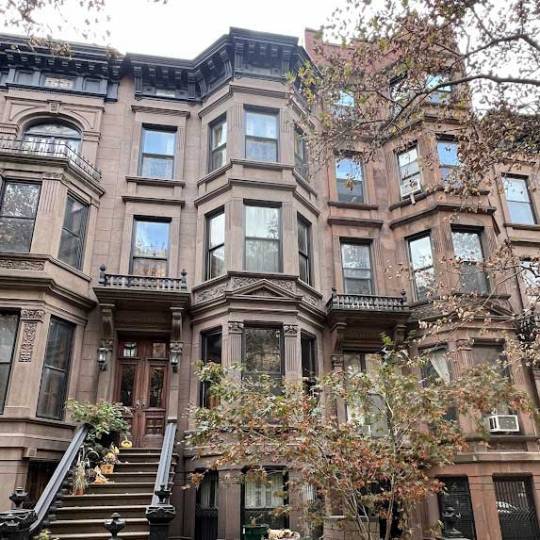
The Ultimate List of Top 10 Brownstone Restoration Contractors in Brooklyn, NY
Brooklyn, NY, is famous for its iconic brownstones, reflecting its rich architectural heritage. These structures require specialized care to preserve their historical beauty and structural integrity. If you own a brownstone in Brooklyn, working with experienced restoration contractors is essential. Here’s a detailed look at the top 10 brownstone restoration contractors in Brooklyn, including Captain Renovation & Contracting Inc., to help you make an informed choice.
1. Captain Renovation & Contracting Inc.
With over 30+ years of experience, Captain Renovation & Contracting Inc. has established itself as a trusted name in Brooklyn’s brownstone restoration industry. Specializing in facade restoration, cornice repair, masonry pointing, and waterproofing, they combine traditional craftsmanship with modern techniques. Known for their dedication to quality, the company ensures that every project meets the aesthetic and structural requirements of brownstone owners.
Why Choose Them?
Decades of expertise in restoration and renovation
Focus on preserving architectural integrity
Comprehensive services tailored to client needs
2. American Architectural Restoration
American Architectural Restoration specializes in restoring the historic charm of Brooklyn’s brownstones. From brick repointing to intricate decorative plasterwork, they provide a range of services to keep your property true to its original design.
Services Offered:
Masonry repair
Historical facade restoration
Waterproofing solutions
3. Brooklyn Restoration Pros
Brooklyn Restoration Pros are highly rated for their customer-centric approach and attention to detail. Their team of skilled artisans ensures every brownstone restoration project is completed to perfection.
Specialties:
Stone cleaning and repair
Brownstone facade coating
Restoration of historical details
4. PM Masonry Restoration
With a strong focus on masonry, PM Masonry Restoration has earned a reputation for high-quality brownstone repairs. Their team understands the unique challenges associated with brownstone materials, delivering solutions that stand the test of time.
Services Include:
Masonry pointing
Brick and stone repair
Stucco application
5. Epic Restoration NYC
Epic Restoration NYC excels in combining traditional craftsmanship with modern technology to provide outstanding restoration services. They are experts in maintaining the structural integrity of brownstones while enhancing their visual appeal.
Why They Stand Out:
Use of eco-friendly materials
Expertise in historical preservation
Competitive pricing
6. AJS Masonry Restoration
AJS Masonry Restoration is known for its skilled team and dedication to client satisfaction. Their work on Brooklyn’s brownstones reflects precision and attention to detail, ensuring long-lasting results.
Core Services:
Brick restoration
Cornice repairs
Custom masonry work
7. All Borough Restoration
All Borough Restoration has been serving Brooklyn for decades, offering high-quality restoration services for brownstones. Their team works closely with clients to ensure the original design elements are preserved while addressing structural issues.
Services Provided:
Brownstone patching and resurfacing
Facade maintenance
Water damage repair
8. Brickstone Masonry & Restoration
Brickstone Masonry & Restoration is a family-owned business specializing in brownstone and masonry restoration. They are committed to preserving Brooklyn’s architectural heritage through meticulous craftsmanship.
Notable Features:
Affordable pricing
Expertise in decorative restoration
Strong client recommendations
9. Renaissance Restoration NYC
Renaissance Restoration NYC is a trusted name in historical restoration, offering services that ensure your brownstone retains its historical charm while meeting modern standards.
Their Offerings Include:
Stone carving and detailing
Restoration of cornices and lintels
Waterproofing and sealants
10. Empire Restoration & Masonry
Empire Restoration & Masonry is known for its technical expertise and artistic approach to brownstone restoration. They offer personalized solutions tailored to the unique needs of each project.
Key Services:
Facade cleaning and repair
Structural assessments
Masonry design enhancements
Choosing the Right Contractor for Your Brownstone
When selecting a brownstone restoration contractor in Brooklyn, consider the following factors:
Experience: Choose a contractor with a proven track record in brownstone restoration.
Specialization: Look for companies specializing in brownstone materials and historical preservation.
Client Reviews: Research testimonials and reviews to gauge customer satisfaction.
Licensing and Insurance: Ensure the contractor is fully licensed and insured to protect your investment.
Portfolio: Review their previous projects to ensure their work aligns with your vision.
Why Invest in Professional Brownstone Restoration?
Brownstones are more than just homes—they are a piece of history. Professional restoration enhances their value, ensures structural safety, and preserves their historical charm.
With Brooklyn’s top contractors, including Captain Renovation & Contracting Inc., you can ensure your property stands out while maintaining its timeless elegance. Whether it’s facade restoration, waterproofing, or intricate masonry work, these professionals have the skills and experience to bring your vision to life.
#Brownstone in Brooklyn#experienced restoration contractors#brownstone restoration contractors in Brooklyn#facade restoration#cornice repair#masonry pointing#waterproofing#decorative plasterwork#Masonry repair#Historical facade restoration#Waterproofing solutions#Stone cleaning and repair#Brownstone facade coating#brownstone repairs#brownstone materials#Brick and stone repair#Stucco application#restoration services#historical preservation#Brooklyn's brownstones#Brick restoration#Cornice repairs#Custom masonry work#Brownstone patching and resurfacing#Facade maintenance#Water damage repair#brownstone and masonry restoration#brownstone retains#Stone carving and detailing#Restoration of cornices and lintels
1 note
·
View note
Text
Safeguarding Chicago's Past: A Guide to Historic Masonry Restoration
Chicago's cityscape is a captivating tapestry of architectural styles, each whispering stories of the city's rich history. However, the very elements that give these structures their character – brick, stone, and terra cotta – are susceptible to the ravages of time and weather. This is where historic masonry repair services come in, playing a vital role in preserving these architectural gems for future generations.
Historic masonry restoration transcends mere repairs; it's a meticulous process that demands a deep understanding of traditional building techniques and materials. Unlike modern masonry, historic structures often utilized specialized materials and construction methods. Experienced restoration specialists possess the knowledge and expertise to:
Identify Deterioration: Through a rigorous inspection process, they meticulously assess the extent of damage, pinpointing factors like cracked mortar joints, spalling bricks, or failing lintels.
Match Materials & Techniques: Modern materials might not aesthetically or structurally integrate well with historic masonry. Restoration professionals source or custom-mix materials that are compatible with the existing structure, employing traditional techniques for a seamless and historically accurate restoration.
Preserve Architectural Details: Ornate cornices, decorative brickwork, and intricate stone carvings are hallmarks of historic buildings. Restoration specialists take meticulous care in preserving these details, ensuring the restored facade retains its architectural integrity and character.
Historic masonry repair goes beyond aesthetics; it's a matter of structural integrity. Left unaddressed, deterioration can compromise the building's stability, leading to costly and extensive repairs down the line. Addressing issues like:
Water Infiltration: Failed mortar joints and deteriorated flashing can allow water to penetrate the facade, leading to structural damage, mold growth, and efflorescence (mineral deposits). Historic restoration services address the source of leaks, repair flashing, and apply appropriate waterproofing treatments.
Movement and Settling: Over time, a building's foundation can settle, causing cracks and misalignment in the masonry. Restoration specialists employ specialized techniques to stabilize the structure and address any movement-related issues.
Chicago boasts a thriving landscape of commercial masonry restoration contractor Chicago. Selecting the right partner for your historic restoration project requires careful consideration. Here are some key factors to prioritize:
Experience in Historic Restoration: Look for a contractor with a proven track record of successfully restoring buildings from a similar era and architectural style.
Understanding of Preservation Guidelines: Many historic structures fall under preservation guidelines established by local historical societies. Choose a contractor familiar with these guidelines and committed to adhering to them.
Skilled Craftsmanship: Historic restoration demands a high level of craftsmanship. Look for a contractor who employs skilled masons experienced in traditional techniques and meticulous attention to detail.
Clear Communication and Collaboration: Restoring a historic building is a collaborative effort. Choose a contractor who maintains open communication, actively engages in discussions about the project's goals, and welcomes your input.
By investing in masonry restoration services, you're not just protecting a building; you're safeguarding a vital piece of Chicago's history. These restored structures continue to stand as testaments to the city's architectural heritage, adding cultural and economic value to the vibrant urban landscape.
0 notes
Text
The Art of Landmarks Exterior Restoration
Introduction: As the leading brownstone restoration contractor in Brooklyn and Manhattan, Innovation Construction NY takes great pride in preserving the beauty and charm of historic brownstone buildings. With decades of successive commitments and a track record of delivering quality work, our team specializes in landmarks exterior brownstone restoration, brick facade restoration, masonry, brick pointing stucco, and waterproofing. In this post, we will delve into the importance of preserving these architectural gems and the services we offer to ensure their longevity.
Celebrating Architectural Heritage: The historic brownstones of Brooklyn and Manhattan are not just buildings; they are treasured pieces of architectural heritage. Our restoration work aims to honor the rich history and cultural significance of these landmarks, breathing new life into their facades while preserving their original charm.
Expertise in Brownstone Restoration: At Innovation Construction NY, we have a dedicated team of skilled craftsmen with deep expertise in brownstone restoration techniques. From meticulous brickwork and intricate stonework to seamless mortar matching, our professionals employ the highest standards to deliver outstanding results.
Brick Facade Restoration: The exterior brick facades of brownstones are prone to weathering and damage over time. Our restoration services include expert brick cleaning, repair, and replacement, ensuring that the facade retains its structural integrity and visual appeal.
Masonry Excellence: We understand the art of masonry and its crucial role in brownstone restoration. Our experienced masons excel in restoring ornate cornices, window sills, lintels, and decorative elements, meticulously replicating the original design while using durable materials for long-lasting results.
Brick Pointing and Stucco: Brick pointing is essential to prevent moisture penetration and maintain the stability of brownstone walls. Our team performs precise brick pointing techniques, seamlessly matching the original mortar color and texture. Additionally, we offer stucco application services, providing an extra layer of protection against the elements.
Waterproofing for Longevity: Water damage is a common issue faced by brownstone buildings. Our comprehensive waterproofing solutions ensure that your property remains protected from water intrusion, preventing structural deterioration and potential mold growth.
Conclusion: Innovation Construction NY is committed to the meticulous preservation and restoration of historic brownstones in Brooklyn and Manhattan. By combining our expertise, craftsmanship, and commitment to quality, we help property owners maintain the beauty and integrity of these architectural treasures for generations to come. Contact us today to learn more about our services and experience the transformative power of our brownstone restoration expertise.
Remember to customize the content to reflect your company's specific values, services, and achievements.
1 note
·
View note
Photo
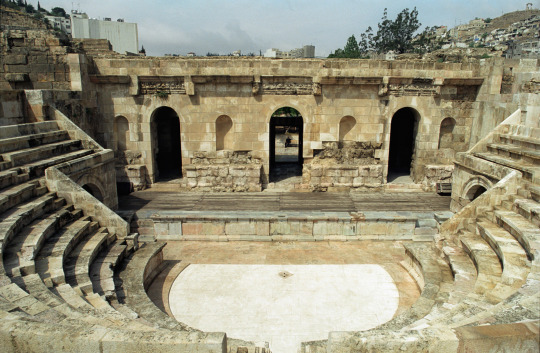
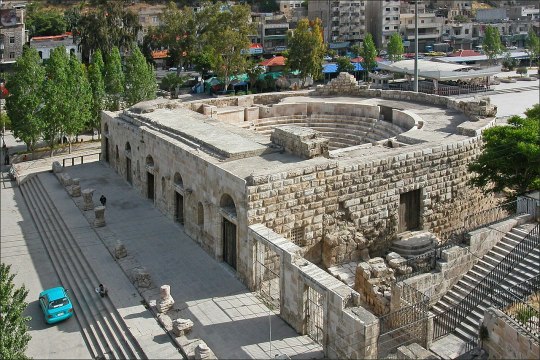
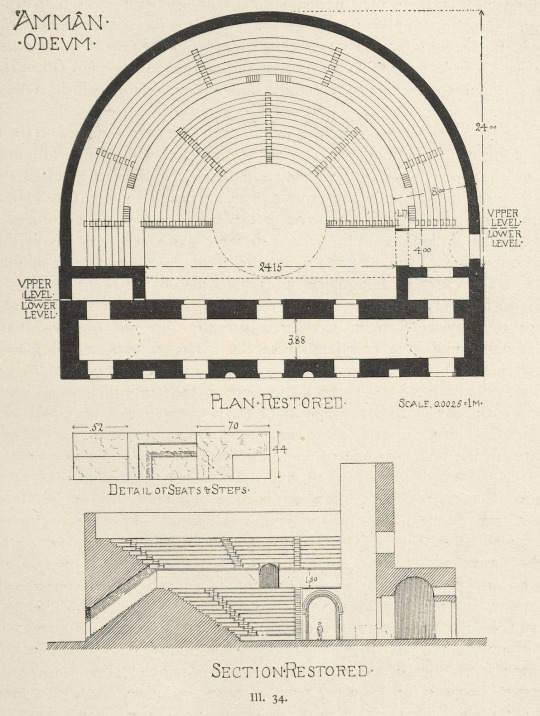



Odeon of Amman
Philadelphia (Amman), Jordan
2nd century CE
500 seats
Odeon ("singing place") is the name for several ancient Greek and Roman buildings built for music: singing exercises, musical shows, poetry competitions, and the like. Archaeologists have speculated that the Odeon of Amman was most likely closed by a temporary wooden roof that shielded the audience from the weather.
This Odeum is a Roman one, built in the 2nd century CE, at the same time as the Roman Theatre next to it.
Sources and more text below.
“The small theatre, or odeum, faces west upon the open space in front of the great theatre. Its southwest angle is about 5 m. east, and 14 m. north of the northeast angle of the theatre. It was built up entirely from the ground level and consisted of an outer west wall with five entrances in it, an inner wall, or proscenium, connected with the outer wall by a tunnel vault, two massive towers which formed the parascenia, and a small cavea divided by a single praecinctio. Of these parts, the first, or western wall, with three of its portals is standing to the height of one story; the doorways on the ends have fallen with the collapse of the angles, leaving one jamb of each with the springers of the relieving arches above them; the inner wall is partly preserved, and portions of the vaulting of the passage between the two walls are still in place; the southern tower is intact in two stories, and its west wall rises to a height of about 15 meters, but the opposite tower is a heap of ruins. The exterior curve of the cavea may still be traced at certain points; but the interior is filled with a mass of debris caused by the collapse of the northern tower and the high wall of the scaena, both of which fell inward. The ruin must have long served as a quarry; for almost all the seats that are not buried in debris have been removed. It was possible for me to find only short sections of four seats, at the extreme end on the south, and here I was also able to secure the measurements of the praecintio. It is plain that this building, though badly ruined, in 1881, when Captain Conder gathered the materials for his plan1 of the odeum, was not in the demolished condition in which we found it twenty-three years later·, for there are details in his description that are not to be found today. Captain Conder published only a plan on a very small scale without any details in the cavea; but his description gives a number of accurate measurements. With these as a check I am able to present the accompanying plan (Ill. 34), for which I cannot lay claim to accuracy in details, and a cross-section which is based largely upon conjecture. Plan. It is not possible, from the minuteness of its scale, to ascertain the precise measurements of Captain Conder’s plan of the odeum, where they are not definitely mentioned in the text; but so far as they are obtainable with the aid of the scale of feet given, they are substantially the same as those which I took. The whole structure, from the front wall to the exterior curve of the cavea, measures 35 m., or, according to Captain Conder’s plan, a little over 100 feet; the extreme width of the cavea is 40 in.; in Conder’s plan, about 125 feet; the stage building, at the middle, through both walls and the vaulted passage measures 7.48 m., in the other plan 25 feet. The old plan gives but three portals in the west wall, and makes this wall shorter than the width of the cavea; Captain Conder apparently did not observe that this wall terminates at either end in a door-jamb with the springers of a relieving arch over it; one of these jambs is shown in the photograph3 published by Captain Conder, the other may be seen in Ill. 35. These doors were of the same dimensions as the others, and, when they are restored, the length of the west wall will be equal to the width of the cavea. Captain Conder shows towers projecting inward at either end of the scaena wall; he states in the text that one of these towers measures 11 feet east and west, and 25 feet north and south. By this he must have meant that the north side adjoining the scaena wall measures 11 feet, and that the east wall was 25 feet long outside; for the south wall of the tower, now standing, is nearly 5 m. long. The earlier plan moreover places the centre of the semicircles of the cavea upon a line connecting the angles of these towers; but such a centre will not give a radius long enough to touch the rear curve of the cavea, which we agree is 35 m. from the west wall, without increasing the width of the cavea which we know to be 40 m. The measurement from the wall of the praecinctio at one end, to the corresponding point opposite is 24.15 m. In my plan I have therefore moved the centre backward 4 m. and I have constructed the semicircles of the cavea within the prescribed dimensions. This arrangement gives a space 4 meters wide for the paradoi. Down under the debris on the north side I measured a vault 4 meters wide, east and west, and a series of carved voussoirs of an arch that must have had a span of at least 3.70 m. I believe that the vault was the vault of the parados and that the arch-stones belonged to the arch which opened from it toward the orchestra. Captain Conder found seven rows of seats above the praecinctio; there could never have been more, if there were any passage at the top of the cavea: I found only four rows of seats, and no remains of seats below the praecinctio have ever been reported. Captain Conder describes three vomitoria from the cavea, one in the middle of the curve and one on either side. Only the barest remains of these are now visible. It is evident that these led from the praecinctio down to the level of the ground outside. The side of one such opening in the wall of the praecinctio is still to be seen on the south side at a distance of 5.75 m. from the tower wall. If the height of the praecinctio above the ground level be as I have indicated it, the steps of the vomitoria will descend from the praecinctio to the ground level at the outer curve of the cavea wall, at the same angle as the steps of the scalae within. These exits, of course, had vaults; these are likened, by Captain Conder, to segments of a hollow cone. Supers true hire. Satisfactory measurements of heights are out of the question in a ruin so filled with debris, unless the debris is removed; I have attempted to give a cross section, reconstructed in, what seems to me, the most logical method with the data in hand, and from what we know of the other buildings of a similar character. The ground level is, of course, unobtainable in a ruin of this character; but one may begin with the praecinctio, of which a small section is preserved, and place above it seven rows of seats with a narrow passage above them; parts of a scala are to be seen near the south end; the seats and the praecinctio terminate against the long wall of the tower. Of this much we may be reasonably certain; but the reconstruction of the cavea below the praecinctio depends entirely upon the existence of paradoi passing under the praecinctio and the upper section of seats at their extreme ends (Ill. 34). If there were paradoi at this point, a complete half circle of seats must be provided for within, i. e., east of, the paradoi, and the number of seats must be great enough to furnish height for the entrances on either side. I have assumed that the vault 4 m. wide is the vault of the parados, and that the voussoirs belonged to the arch of the entrance, and have therefore given a height to the lower section of the cavea, that will allow for ten rows of seats and a barrier about the orchestra 70 cm. in height. This arrangement provides for an orchestra 10.75 m. in diameter, and the semicircle of the orchestra, if continued to a circle would be tangent to the front line of a stage 2 m. deep. The standing portion of the south tower still towers above the rest of the ruin (Ill. 35), but in 1881, according to Captain Conder’s photograph, it was much higher, and was estimated by him to be 50 feet, about 17 m. high. This would give a scaena wall of at least that height. From indications in my photograph, as well as that published by Captain Conder, it is evident that there were large arched windows in the first story of the scaena wall above the vaulted passage at the rear of the stage: the jamb of the window and one voussoir are to be seen at the north side of the tower where a short section of the scaena wall is still in situ. It is very doubtful if the front wall of the odeum was carried up for an upper story; there is hardly enough debris to warrant it; yet this might have been carried away for building material; but the fact that the west wall of the tower, and the face of the section of the scaena wall still clinging to the tower, are both faced with draughted masonry, seems to show that they were exterior walls, although the rustication is carried to the base of the tower behind the vaulted passage of the postscenium. The outer wall is of finely dressed smooth ashlar, the portals were provided with arches of discharge above flat, three- piece lintels, the frame mouldings are of good but simple profile. On either side of the middle portal was a semicircular niche, and in the next spaces were rectangular niches with round arches. Beside each relieving- arch there were corbels in the wall which were more probably inserted to sustain the beams of a colonnade than to hold statues. The greater part of the ornamental details of the building has disappeared. The interior contains among its heaps of broken fragments several fine pieces of well wrought friezes and cornices which show that the scaena was richly adorned with entablat- ures. The mouldings of the seats were substantially like those of the great theatre (Ill. 34, detail), and have no resemblance to the detail given by Captain Conder, which must have been made from a broken example. “
(Text is told first hand by Howard Crosby Butler, who wrote the Syria series)
Sources: 1, 2
#art#Architecture#travel#history#roman#roman art#roman architecture#odeum#odeon#theatre#theater#amman#jordan#Philadelphia#2 ce#corinthian#roman theater#roman theatre
389 notes
·
View notes
Photo










State Street, Chicago (No. 2)
The Sullivan Center, formerly known as the Carson, Pirie, Scott and Company Building or Carson, Pirie, Scott and Company Store, is a commercial building at 1 South State Street at the corner of East Madison Street in Chicago. It was designed by Louis Sullivan for the retail firm Schlesinger & Mayer in 1899, and expanded by him and subsequently sold to H.G. Selfridge & Co. in 1904. That firm occupied the structure for only a matter of weeks before it sold the building (the land under it was owned at the time by Marshall Field) to Otto Young, who then leased it to Carson Pirie Scott for $7,000 per month, which occupied the building for more than a century until 2006. Subsequent additions were completed by Daniel Burnham in 1906 and Holabird & Root in 1961.
The building has been used for retail purposes since 1899, and has been a Chicago Landmark since 1975. It is part of the Loop Retail Historic District.
The Sullivan Center was initially developed because of the Chicago Great Fire of 1871. In 1872, the partnership of Leopold Schlesinger and David Mayer began after their immigration from Bavaria. In 1881 Schlesinger and Mayer had moved their dry-goods store into the Bowen Building that was on the corner of State and Madison. In 1890, Schlesinger and Mayer hired Adler and Sullivan to prepare plans for the removal of the Bowen Building's attic story and the addition of two stories across the Bowen Building and the adjacent four-story structure to the south. The facades were added to match the bottom stories of the building and the building was painted white.
In 1892, Schlesinger and Mayer hired Adler and Sullivan to do further remodeling and add a new entrance to the corner of State and Madison. In 1896, Sullivan, no longer working with Adler, was asked back by Schlesinger and Mayer to redesign the façade and add two stories to the newly leased four-story building on Wabash avenue, as well as connecting it to the State Street store. That never happened because Schlesinger and Mayer changed their minds to make it a ten-story building, which also never happened. It eventually got painted white and then a bridge was added that connected the second story of the building to the elevated railroad. In 1898, Schlesinger and Mayer decided to remove the original building located on State and Madison replace it with a new building designed by Sullivan. Sullivan had both a nine and twelve-story proposal made up for this new building. They eventually started with a nine-story portion of the building that was made on the Madison Street side next to the original portion of the Adler and Sullivan renovations.
In 1902 Schlesinger and Mayer came back to Sullivan wanting a twenty-story building on State and Madison, eventually settling for the final twelve stories. The Madison Street portion that was added earlier did not structurally support twelve stories so it was left as is. Sullivan came up with a three-stage plan to finish the new building and allow Schlesinger and Mayer to keep their business running during the Christmas season.
The building is remarkable for its steel-framed structure, which allowed a dramatic increase in window area created by bay-wide windows, which in turn allowed for the greatest amount of daylight into the building interiors. This steel framed structure uses the post-and-lintel technique to provide a strong, light, and fireproof steel skeleton. The exterior of the building consists of a grid of piers and spandrels that reveals the post-and-lintel technique that supports the building. The design was the first use of what became known as the Chicago window. At street level, the broad expanses of glass allowed for larger displays of merchandise to outside pedestrian traffic creating the idea of the sidewalk showcase. In between the windows were bands of terra cotta, replacing an earlier plan for white Georgia marble, to save cost and weight and to avoid delays arising from a stonecutter's strike. The design featured bronze-plated cast-iron ornamental work above the rounded tower. The project also included a fire suppression sprinkler system, supplied from a 40-foot (12 m) water tower on the roof.
Sullivan designed the corner entry to be seen from both State and Madison. The attractive ornamentation above the entrance would give the store an elegant and unique persona important to the building's competition with neighboring stores. The building is one of the classic structures of the Chicago school. The way this technique was used on the lower floors of the building was so elaborate that it used the natural lighting and shadows to seem almost as if it were magically floating above the ground. The top floor of the 1899 and 1904 sections of the building were recessed to create a narrow loggia topped by an intricately detailed cornice that projected beyond the facade of the building. This was removed around 1948 and the 12th floor redesigned to replicate the lower floors.
In the early years of development there was an addition that grew to be very valuable in spotting the building from afar. This addition was the pedestrian bridge that connected the train station, behind the store on Wabash Avenue, to the second floor of the Sullivan Center. This too was coated in elaborate metalwork and provided a sense of special entry to those who used it.
In February 2006, the first phase of a multi-year restoration of the building's upper facade was completed. In addition to cleaning, the cornice and supporting columns were recreated on the 12th floor. A 2001 report put the budget at $68.9 million for this renovation.
In August 2006 the parent company of Carson Pirie Scott, (Bon-Ton Stores Inc.), announced that after the 2006 Christmas season, the department store in the building would close. There were no immediate announcements as to what would occupy the building after the store's closure. After holding clearance sales, Carson's closed in February 2007.
The 943,944-square-foot (87,695.3 m2) three-building complex, now renamed the Sullivan Center, is currently owned by Madison Capital, a private real estate company based in New York, New York.
In 2008, a second renovation project of the decorative iron work on the lower three floors began. This included the State Street facade as well as rear portions of the building which face Wabash Avenue. Part of the funding for this renovation was provided by the City of Chicago. The Wabash facade was completed in August 2009 and the work on State Street in late 2010.
Tenants of the Sullivan Center include the School of the Art Institute of Chicago and Gensler. In December 2010, Freed and Associates announced it was in talks with retailer Target, who expressed an interest in occupying part of the structure. On February 15, 2011, the retailer announced it would lease 125,000 sq ft (11,600 m2) spread over two floors of the building. The new store opened July 26, 2012 and was met with favorable reviews for its clean design while being sensitive to the historic character of the structure.
Source: Wikipedia
#State Street#architecture#cityscape#urban photography#travel#vacation#Chicago#Illinois#summer 2019#original photography#1 South State Street#Sullivan Center#Louis Sullivan#Daniel H. Burnham#façade#exterior#USA#Carson Pirie Scott and Company Building#Chicago School#deteil#window#Midwestern USA#Great Lakes Region
3 notes
·
View notes
Photo


Hughes One-room Schoolhouse
Liberty Township Historical Society
6040 Princeton Road
Hamilton, OH 45011
Hughes School is a historic school building in Liberty Township, Butler County, near Hamilton, Ohio. The land for the school was given to School District No. 4 by Nicholas Curtis in 1832. Elijah Hughes served as school director for the district at that time and is mentioned in the original deed. The school was built in 1887. Historically a one-room school, the rectangular brick building rests on a stone foundation. The gabled roof has corbeled cornices and the double door entry has a four pane slightly rounded transom. The entry is in a two-story projecting bay that was topped with a bell tower with pyramidal roof. A pair of six over six double hung sash windows flank the door with wooden shutters louvered on top and paneled below. These windows and the door have arched keystone lintels with stone keystones and caps. Brick pilasters divide each side of the building into four bays the rear three have windows which duplicate the windows on the facade. The Hughes School is an example of 19th century one–room schoolhouse architecture.
The Liberty Township Historical Society was formed by a group of residents with an interest in preserving and restoring the Hughes One-room Schoolhouse, which was built in 1887 and used until 1922. The brick structure on Princeton Road adjacent to Liberty Elementary School was falling into disrepair and was destined for demolition. The research, design, and funding, as well as the labor, were the society’s primary mission for many years. Upon completion of the restoration the group was successful in having the school placed with the National Registry of Historic Places on Jan. 2, 1976. A committee of the organization created a commemorative quilt depicting historic persons, places, and events significant to Liberty Township and is currently on display at the township’s administrative offices. Several members have also been active in the restoration and documentation of local cemeteries. A goal of The Liberty Twp. Historical Society is to ultimately create a local museum. This would serve as a site to collect, preserve and display items, photographs, etc. of local interest. They are currently interested in accepting photographs and memorabilia or at the least electronically scanning such items. Another current project includes video taping area residents as they relate their personal history, local folklore, stories and anecdotes. The Liberty Township Historical Society meets at the Hughes School on Princeton Rd at 7:00 PM each Month on the second Thursday. The school is available for tours by appointment.
0 notes
Text
Bright white walls contrast historic facade of MM34 apartments in Mexico City
Mexican architect Inca Hernández has renovated and refurbished a crumbling historic building to create apartments in Mexico City.
Located in Tacuba neighbourhood, the Mar Mediterraneo 34 (MM34) building was originally completed in 1910 and had since fallen into disrepair.
Hernández aimed to return the facade to its original design
"At the end of the 19th century and the beginning of the 20th century, Tacuba became one of the wealthiest areas of the city with large country houses, which over time and different political changes were abandoned and many were collapsed," said Hernández.
"However, among these vestiges the house of Mar Mediterraneo 34 remained."
Crumbling brick walls at the rear are updated with white plaster
Hernández's aim for the project was to reference the history of the building, which he said was valued by National Institute of Fine Arts and the National Institute of Anthropology and History, while also creating contemporary apartments.
His response was to do that quite literally by splitting MM34 into two styles: one has refurbished elements of the old structure and the other half features the original clay-brick walls covered in bright white plaster.
Decorative details run throughout MM34
"The project started with the idea of giving a new life to a house designed in two volumes, where the first incorporates the main facade while the second has a view to the main patio, although both were in advanced deterioration and the second volume was in ruins," he explained.
Salvaged and restored existing elements of the historical building include the balconies and lintels, iron railings, large windows and glass roof tiles. Where new materials were used, the architect chose those made by local artisans to pay homage to its eclectic French style.
Large windows floor the apartments with daylight
"The roof dome was rebuilt with a ceramic tile that reinterprets the original glass plates, the same happens with the cornice bordered with Mexican glazed ceramic pieces," Hernández explained.
"The windows of the mansards still preserve some of the original pieces; the missing ones were replaced with Talavera mosaic."
The windows also offer views to the courtyard at the rear
Hernández's restoration work also continued through the interiors of the property, where glass and aluminum window and door frames were added, and floor were reinforced with metal beams and covered in plaster.
Measuring 620 square metres, MM34 has seven apartments across its three floors. They include lofts, studios family apartments and penthouses.
A perforated screen creates patterned lighting inside
The homes are flooded with daylight from large windows that also offer views to a rear courtyard. White walls continue inside, where the floors are a mixture of wood and decorative tile.
A number are double-height and have mezzanines floors where the bedrooms are located.
Other apartment buildings in Mexico City include a concrete complex designed by American architecture firm Studio Rick Joy and a building by Arqmov Workshop sheathed in a patchwork of vibrant laminate panels.
Photography is by João Morgado.
Project credits:
Development: Top Project Multiplex / Efraín Hernández Interior design: Ana Ximena García, Inca Hernández, Raíz Mx, Adrián González (Mercado de Chacharitas) Collaborators: Gabriela Llovera Arciniegas, Luis Enrique Vargas Structural engineering: Javier Soria
The post Bright white walls contrast historic facade of MM34 apartments in Mexico City appeared first on Dezeen.
0 notes
Text
King Street Station is worth a blog post on its own.
Luckily the station from 1906 was saved from the wrecking ball and restored to its former beauty. From the station’s homepage:
King Street Station first opened to the public in May 1906. Reed and Stem, the architectural firm responsible for New York City’s historic Grand Central Terminal, designed the station. The San Marco bell tower of Venice, Italy, served as the model for the building’s familiar clock tower. The structure was placed on the National Register of Historic Places in 1973.
King Street Station, located on Jackson St between 3rd and 4th Ave S, is a brick and granite three-story building with a twelve-story clock tower. The ground floor, accessed from King St, is clad in granite. The walls of the second and third floors, as well as the clock tower, are faced in pressed brick with decorative terra cotta elements such as cornices and window lintels.
The interior boasts a grand waiting room with ornamental plaster ceilings and fluted Corinthian columns. Bronze chandeliers and wall sconces provide illumination for the passengers inside the station. The terrazzo floor has inlaid square mosaic tiles. This creates a compass shaped pattern at the station entrance and other rectangular patterns throughout the rest of the areas.
While much of the exterior of King Street Station remained intact since the building was constructed in 1906, parts of the interior were substantially altered in a series of renovations in the 1940s, 50s, and 60s and others suffered neglect. In February 2008, the City of Seattle purchased the landmark building from Burlington Northern Santa Fe Railway Company (for $10!) with the goal of bringing back the grandeur of America’s Gilded Age. The restoration of King Street Station ensured that it remains a critical transportation hub and gateway into Seattle for the next hundred years.
Now Seattle is transforming King Street Station into a hub for arts and culture.

The King Street Station with the once highest tower in Seattle

The ceiling and plaster walls and lamp in the renovated King Street Station

A view from the upper floor on the waiting area of Kings Street Station, Seattle.

Detail of the column under the roof of Kings Street Station, Seattle.

The upper floor at King Street Station and the central bronze candelabra

Lamps and the mosaic decoration underneath at King Street Station

Detail of a column and the ornate decoration underneath at King Street Station
Pictures from the historic King Street Station shown on a poster
The roof is put back to the original at King Street Station Seattle
Description of the renovation at King Street Station Seattle.
Description of the renovation at King Street Station Seattle.
Description of the renovation at King Street Station Seattle.
Description of the renovation at King Street Station Seattle.
Description of the renovation at King Street Station Seattle.
These posters show the renovation project. You can click on them to see the text on the findings.

An iconic poster from King Street Station. WPA (Work Project Administration) 907 posters produced during the Great Depression 1936-1943
I wish modern architects would consider going back to a more beautiful style of buildings. Visiting renovated old historic buildings make a trip to a city very attractive.
King Street Station, Seattle King Street Station is worth a blog post on its own. Luckily the station from 1906 was saved from the wrecking ball and restored to its former beauty.
0 notes
Text
A Yorkville Relic - 412 East 85th Street
In the 18th century summer estates of wealthy New Yorkers like Richard Riker, Archibald Gracie and Peter Schermerhorn dotted the Upper East Side. But the 19th century saw factories being erected near the riverfront and wooden cottages appearing on newly laid out streets. In 1826 the New York Evening Post remarked about the district which would later be named Yorkville. “Twelve months ago here were not more than two or three buildings on the barren rock, where there are now upwards of sixty, some of them built in a good substantial manner.” Although still far from the city proper, the houses were being erected along the Commissioners' street plan mapped out in 1811. At some point--historians give the dates of 1855 to 1861--a comfortable frame home was erected on East 85th Street between what would be First and York Avenues. Generally called "vernacular" in style--meaning a carpenter-builder had drawn the plans with no particular architectural style in mind--the three-bay wide house nevertheless exhibits elements of the current Italianate style in its elliptical arched openings under floating lintels and the deep-bracketed cornice. As with similar houses in the mostly rural district there was a small front garden. A stoop led to the parlor floor where the floor-to-ceiling parlor windows welcomed cooling breezes during warm summer months. In the years before the house was constructed Yorkville saw an increase in population as Irish and German immigrants moved here not only to work in the breweries and factories, but to help build the Croton Aqueduct. An Irish family was living at No. 412 East 85th Street by the late 1860's. James Coss was born in Ireland in 1840. On March 10, 1870 his wife, Margaret, gave birth to twins. But merely enduring childbirth in the mid-19th century did not guarantee survival for the infants. At just five months old, little Margaret Coss died in the 85th Street house on July 24. Her tiny casket was placed in the parlor until her funeral two days later. The house was lost in foreclosure in June 1875 and purchased at auction by Martin Clear and his wife, Annie. Clear's commute to his poultry business downtown was not as difficult as might be imagined. Streetcars ran along Second and Third Avenues starting in 1858; and the Third Avenue elevated railroad would open in 1878. Martin and Annie seem to have been financially comfortable. In 1878, for instance, the Department of Public Charities and Corrections accepted his bid to provide 13,650 pounds of poultry to its various institutions. The Clears rented a room in 1879 to the unmarried Denie D. Matthews, a school teacher in the Girls' Department of Grammar School No. 37 on East 87th Street. In 1880 Martin transferred the title to his wife. The same year he enlarged the house by extending the basement forward. It now provided a commodious front porch--no doubt a frequent refuge on warm summer evenings. Simultaneously a third floor was added to the rear extension. The architect was Julius Boekell who was responsible for scores of buildings but is largely forgotten today. The renovations cost Clear a significant $6,000--about $148,000 today. Following Martin's death, Annie E. Clear sold No. 412 on January 15, 1896 to Johanna Seebeck. Seebeck, a real estate operator, paid the equivalent of $295,000 in today's money. She sold it on May 2, 1901 to Marie Steindler and Elias Gussaroff. They, too, were in the real estate business and before long would partner as Gussaroff & Steindler. As Johanna Seebeck had done, the new owners leased the house. In 1908 it was home to Joseph Rosenberg, who was appointed a Commissioner of Deeds that year. But before 1915 the family of John Herbst was living here and would remain for decades. Herbst was well-known as a maker of granite and marble monuments. He had started out as a partner with Otto Schaefer in Herbst & Schaefer "a monumental firm at 41 East Forty-fifth street," as described in Stone magazine in July 1901. But theirs became a rocky alliance, ending that summer with Otto Schaefer filing suit "against John Herbst for a dissolution of the firm." Herbst forged ahead, forming Herbst's Marble & Granite Works. While his stone yard was located at No. 440 East 92nd Street, he kept an office in the 85th Street house. And used the front yard as a showroom.
Gravestones fill the front yard around 1916. from the collection of the New York Public Library
Throughout much of the century many neighborhood children no doubt skittishly scurried past the yard which looked much like a year-round Halloween display. Like the Clears, the Herbsts rented a room in the house for several years. Margaret Glynn lived here at least from 1919 through 1921, receiving a widow's pension from the New York Police Department of $300 per year.
By the time this photograph was taken in 1932 the firm name had been changed. from the collection of the New York Public Library
As the Herbst sons reached adulthood they joined their father's business. Before 1932 it had been renamed Herbst & Sons. The Herbst family remained in the house until 1966. That year the newly-formed Landmarks Preservation Commission placed the house on its list of structures to be considered for landmark designation.
In the meantime, the new owners went ahead with minor interior renovations, installing an apartment on the third floor. With no landmark designation, the historic house got a stroke of good fortune when it was later purchased by Catherine and Alfredo De Vido. The couple restored the house based on early documentation; a project that was aided by the fact that De Vido was an architect. The porch was rebuilt and the clapboards replaced. While De Vido relied on help from the LPC for early documentation, he was not altogether disappointed that the house was not landmarked. The New York Times columnist Matt A. V. Chaban noted on December 8, 2014, "there were some benefits to not having official oversight, such as when he installed simple two-pane windows that were lacking the original arches, as well as wider clapboards."
When Julius Boekell added the third story in the rear for Martin Clear in 1880, he left the original exterior wall intact. The original four-over-four windows and clapboards can still be seen. photo by Nicole Bengiveno, The New York Times, December 8, 2014
In December 2016, exactly half a century after No. 412 East 85th Street first appeared on the LPC's consideration list, it was declared a landmark, insuring its continued preservation. photographs by the author many thanks to reader Holly Tooker for suggesting this post
Source: http://daytoninmanhattan.blogspot.com/2019/02/a-yorkville-relic-412-east-85th-street.html

0 notes
Photo




Temple of Hebran
Hebran, Hauran, Syria
155 CE
This Ionic distyle in-antis temple was not large, and the only fragment in situ is the northeast anta (Ill. 294), which preserves about one half of its original height. An Ionic cap belonging to this anta, and a fine Ionic capital, with all the drums and the base of a column, were found near by. Not far away lay a section of architrave and the conches of three niches. An inscription which probably occupied a position over the lintel of the temple portal, and which gives the date 155 a. d., was also among the fragments on the immediate site.
Pieces of frieze, and one of the cornice with a fragment of raking cornice attached to it, and a part of the lintel and doorcap of the portal, were discovered in a great wall to the east of the temple. To the west of the temple the natural rock falls steeply into the valley. On the south the foundations of the building were partly natural rock and partly artificial wall. On the east a huge retaining wall was built up to support a terrace for the level court which surrounded the temple. Parts of this wall are standing as they were built, others have been patched, and contain fragments of the temple.
In digging for building-stone about the site the natives have turned up a number of capitals and other carved fragments in the Nabataean style, which show that a structure earlier than the Roman temple stood upon the site. It seems probable that the colonnade within the precinct-wall, which had capitals and bases of a Nabataean order, was older than the Roman temple, but remained intact after that building was erected. Indeed it is not impossible that the earlier shrine was not a temple at all in the usual sense, but a “high place” with an altar surrounded by this precinct-wall.
The little temple was of the form known as distyle-in-antis, in plan an oblong of about 8.50 m. by 15 m. outside measurement. The antae were not of the usual form, - simple wall terminations -, but were returned inward forming pilasters provided with bases and caps well within the angles of the walls, which remained quite plain. The caps have two-faced Ionic caps. The two columns were so placed that an arch over the middle intercolumniation was unnecessary.
The front wall was provided with two storeys of niches in addition to the niches in the anta-walls. The interior was spanned by two transverse arches. It is a rare thing to find a building of this period in the Hauran designed in the Ionic style, and it is fortunate that all the details necessary to the restoration of this one were discovered. They are presented in drawings on large scale in Plate XX, and the façade is restored in Ill. 296. In the restoration the base of the wall, the parotids, and the steps are necessarily conjectural, for the reason that there is a deep pile of debris in front of the temple. The height of the order is assumed from the height of the two storeys of niches which is known. The capitals and bases of the columns and pilasters were drawn from originals, and are shown in Plate XX which also presents the architrave, frieze, cornice, and raking cornice, all of which were drawn from originals, as are also the mouldings of the doorway and the inscription which serves as a frieze, and the doorcap; the placing of these last two details being only conjectural. Behind the temple, in the restoration of the façade, I have attempted to reconstruct the colonnade of the peribolos; this I have done on the basis of bases and capitals of small columns discovered in the ruins and shown in Ill. 296, and an entablature copied from a Nabataean colonnade at Si.
(Text by Howard Crosby Butler)
Sources: 1, 2
#art#Architecture#travel#history#temple#syria#hebran#arabia#roman#roman art#roman architecture#roman temple#ionic#distyle#in antis#ionic antae#nabatean
75 notes
·
View notes
Photo


South Temple
Si (Seeia), Hauran, Syria
~ 33 BCE - 50 CE
This is a temple of Classical tetrastyle prosrtyle plan, executed in almost purely Nabataean detail. It was built upon a terrace 5 m. above the outermost court, and on the south side of it. It was approached by a broad flight of steps set into the terrace wall. The area about the temple was paved. The plan is prostyle, tetrastyle, with projecting antae, and interior wall-piers for the support of transverse arches. The temple proper was set upon a podium 2.50 m. high, and tall, narrow, parotids flanked the steps. The order of the four columns is substantially like the Nabataean order known at Hegra and in Bosra.
It is the only example of its kind that has been found at Si. The base consists of a flat torus, a fillet and a scotia, another fillet and a narrow bead below a flat cavetto which answers for an apophyge. The shaft is plain and has a slight diminution. The lower member of the capital is an echinus like that in the similar order in Bosra; but it has four plain leaves which curve up below the “horns” of the much exaggerated concave-sided abacus. The caps of the antae are foliate. They have very large abaci, and the leaves spread well to support their angles. The leaves themselves are of the heavy type of acanthus commonly found here at Si.
I found no piece of architrave, and have introduced in the restoration a triple-banded one like that found in the temple at Suweda, and frequently seen in the tombs at Hegra. I have also introduced a plain frieze, as is often found in the monuments named above. The cornice and raking cornice are both represented in the broken details lying about the temple; the angle-antefixes were restored from broken fragments. The cap-mouldings of the parotids which flanked the steps are different in profile from those of the podium; at least one part which appeared to be in situ (Ill. 341) showed a very different treatment.
This profile is quite unique in Nabataean architecture, and is not found in architecture of the Roman period in Syria; though it is not unlike mouldings that occur in the simas of some of the early Doric buildings in Sicily. The ornament of the doorway is related to that of the portals of the temple of Ba'al Shamin, the grape-vine being the most important motive; but the treatment of the fruit, or the species of grape represented, is quite different. Here the grapes are oblong, like the finest of the grapes that are to be seen to-day in the Djebel Hauran, the leaves, the stem, and the tendrils, are very naturalistically carved. The running vine with bell-like flowers, that forms a narrow band beside the grape-vine was not found elsewhere. This carved decoration appears upon the lintel and jambs of the doorway. At the end of the lintel is an attached console, quite like the other consoles found here in form and scale, but having, as an added enrichment, a cluster of large grapes hanging against its outer face. This is reminiscent of the grape-clusters that depend from the volutes of some of the pilaster-caps of the temple of Ba'al Shamin.
I did not succeed in finding any remnant of the frieze or cornice that undoubtedly rested upon this lintel and its console. No inscription has as yet been found which can be connected with this temple, and there is little in its ornamental details that is serviceable in determining its date. The little carving that remains seems to have much in common with the early work here at Sic, and there is none that partakes of the character of the work which is known to have been executed under the second Agrippa.
Sources: 1
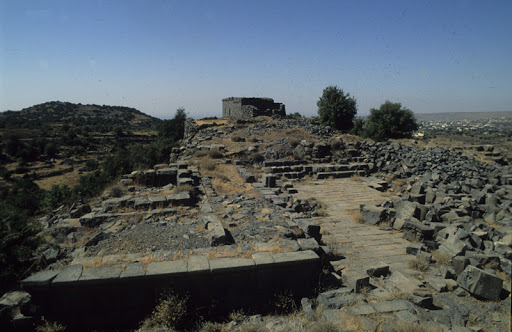
#art#Architecture#travel#history#sia#si#seeia#temple#tetrastyle#nabatean#unique#prostyle#1 bce#1 ce#syria
60 notes
·
View notes
Photo
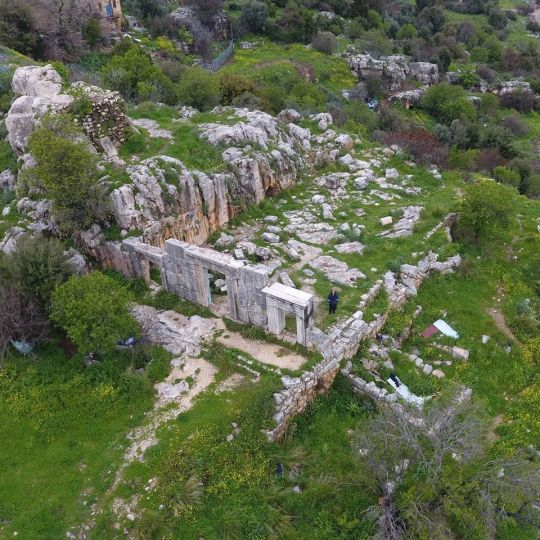
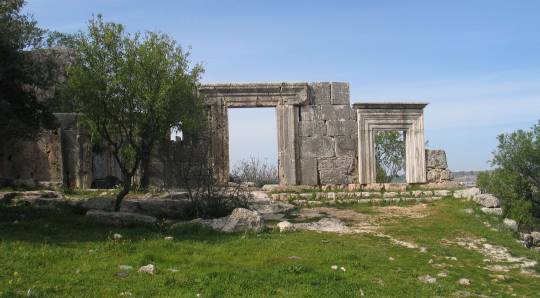

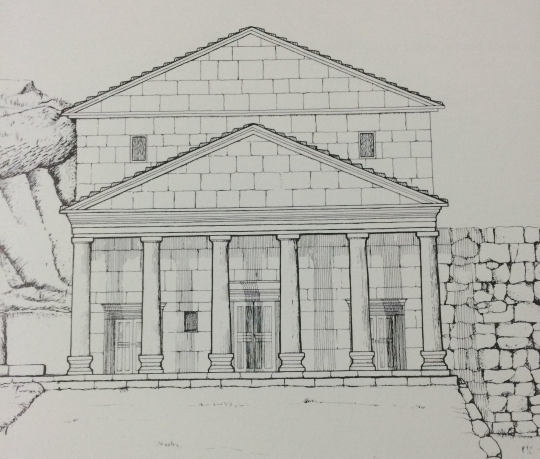
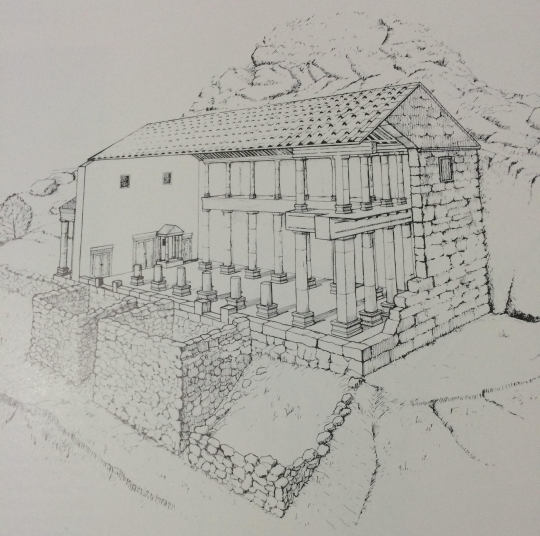
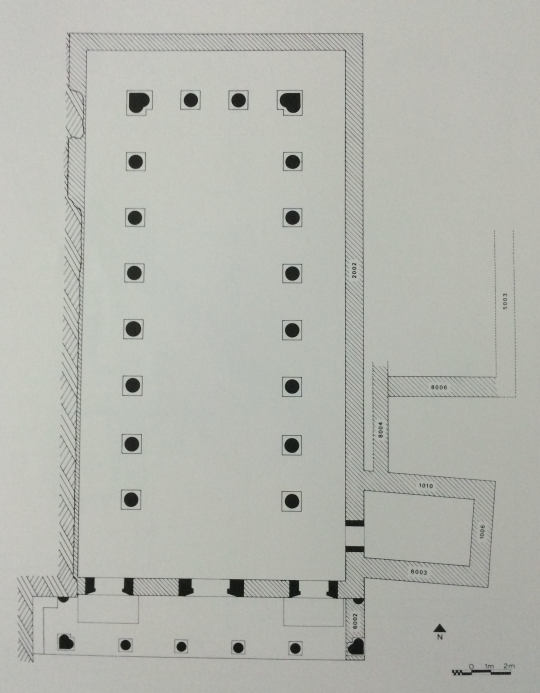
Synagogue of Meron
Meron, Galilee, Israel
1st century CE
The building was 27 m long and about 13.5 m wide and was carved into the mountain. The northern wall of the synagogue is hewn and it is evident that it reached the height of the building. The building's foundation has holes as the foundation for the pillars pedestals which held the roof of the synagogue. The synagogue is aimed at Jerusalem, and is the longest found in the country of its kind so far. From all if its walls, mostly the southern wall survives, which had 3 openings: a central opening, with a cracked lintel, and another, which was restored. In the synagogue, the lintels and the cornices atop of them weren’t decorated with reliefs. Zvi Ilan believes that this is the result of a trend not to over decorate the synagogue's decoration and not an evidence of the economic situation of the local residents, who have invested heavily in the synagogue's construction. The Holy Ark was probably near the main entrance, and no remains were found.
The establishment of the synagogue while investing a great deal in quarrying a building in a relatively large area indicates the great importance that the early residents of Meron gave to the synagogue.
#art#Architecture#travel#history#Synagogue#meron#meiron#galilee#israel#1 ce#doric#basilica#jewish art#jewish architecture#jumblr#ישראבלר#מירון#בית הכנסת במירון#jewish#holyland
299 notes
·
View notes
Photo

McBride House 3029 Prospect Avenue Cleveland, OH 44115 This high design, turn-of-the-century Italianate mansion has a lavish interior including walnut floors, pecan woodwork, and ornate plaster ceilings. The property also includes a restored 3,000 square feet coach house with converted hayloft. All historic design features are intact. Building is ADA compliant. McBride House, originally a private residence, is located midtown on Prospect Avenue, in Cleveland, Ohio’s Prospect Avenue Historic District. It has been the home of two significant Cleveland families over the years. The house was built for William and Francis McBride c.1868. Mr. McBride was a partner in the firm Hussey and McBride Oil Refiners. In 1902 the residence became the winter home of Howard Eels, a manufacturer and philanthropist who owned the Bucyrus Steam Shovel Company. The residence is a two-story brick Italianate house with two two-story bay windows flanking each side of the primary entrance creating a symmetrical facade. There is an ornate frieze, with a bracketed cornice and ornamental wooden lintels all in the Italianate style. There are also two-story bay windows on each side of the house. The restoration and rehabilitation work was extensive both inside and outside the house. New windows were added to match the original profiles, many of which have curved sash and curved glass lights. The entrance porch, which had been destroyed in previous renovations, was recreated using research in several photographic archives. Extensive rebuilding of rotted wood brackets and details was required due to deterioration over the years. The entire brick facade was restored including removal of over five layers of paint, cleaning, and tuck-pointing. The interior room shapes and openings between rooms were reestablished and new finishes in the historic character were implemented throughout. A new stair and elevator connecting four all floors were sensitively inserted for code compliance. The building is now a fully code compliant office complex, inclusive of complete restoration of the main house, servants quarters, and the coach house.
0 notes